The Ultimate Guide To Thailand Pottery: Discover The Rich History And Stunning Artistry

Finding the perfect souvenir to capture your Thailand adventure can be quite a task. Did you know Thai pottery, with its rich history and stunning artistry, makes for an intriguing keepsake? This blog post unravels the intricate world of Thai ceramics, so that you’re well-armed for your pottery hunt.
Get ready – a beautiful journey into Thailand’s iconic craft awaits!
Key Takeaways
- Thai pottery has a rich history that dates back centuries, with influences from the Si Satchanalai and Haripunjaya periods to modern-day techniques inspired by the Chinese Ming dynasty.
- Types of Thai pottery include celadons, Benjarong, Kalong, Lampang, Nakorn Thai and Nan, Pa-O, Phan, Phayao, Phitsanulok, Sankampaeng , Sawankhalok and Si Satchanalai.
- Celadons are known for their beautiful shade of green and have cultural significance in Thailand.
- Benjarong pottery is highly valued in Thailand and features five basic colors – red, green yellow white black – along with intricate Buddhist motifs.
History of Thai Pottery
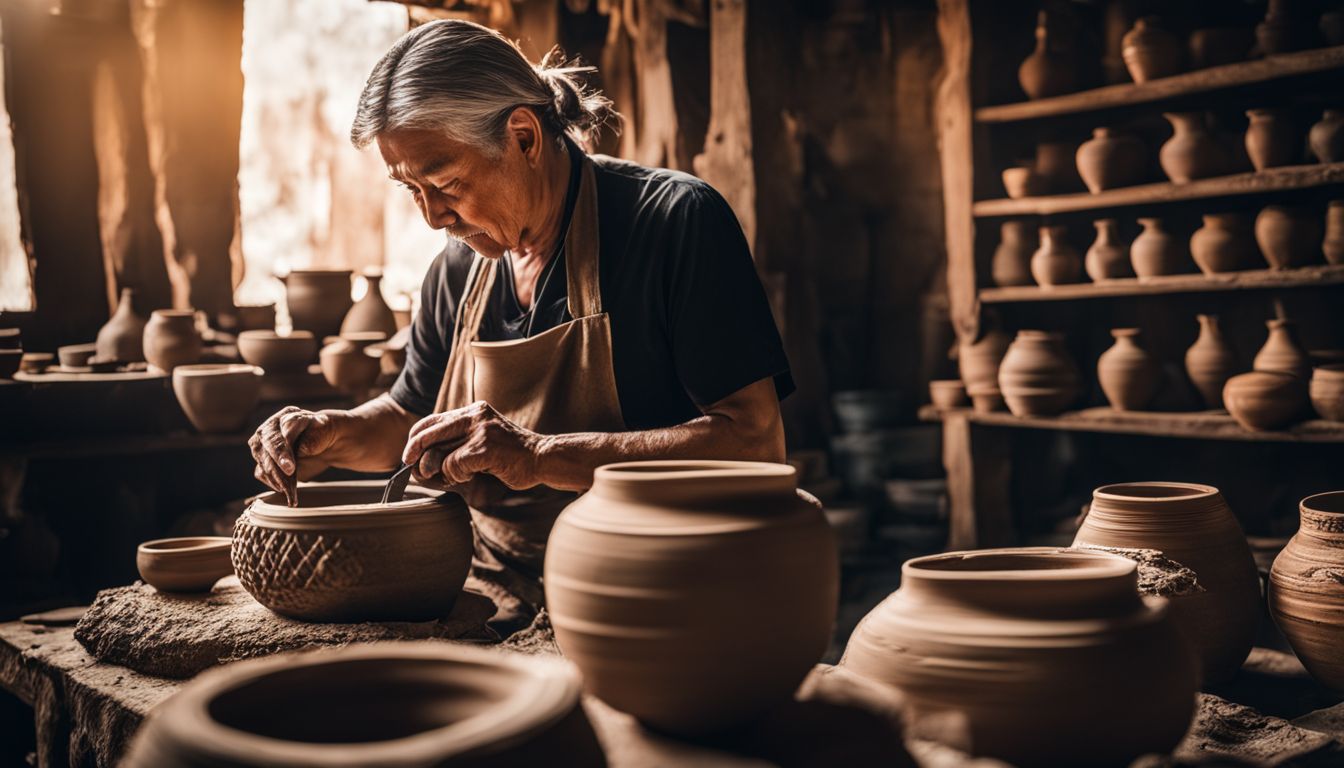
Thai pottery has a rich history that dates back centuries, with influences from the Si Satchanalai and Haripunjaya periods to modern day techniques inspired by the Chinese Ming dynasty.
Si Satchanalai and Haripunjaya
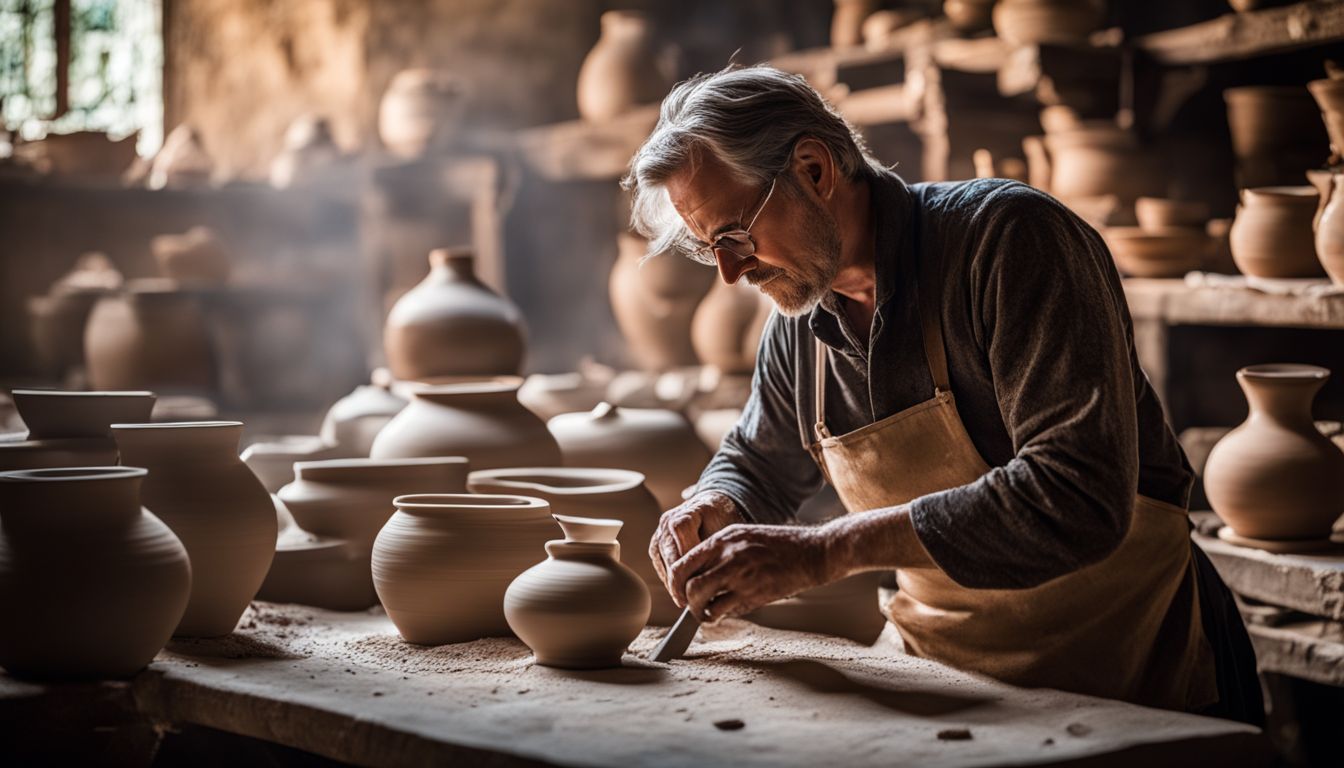 Si Satchanalai and Haripunjaya are in Northern Thailand. They make Thai ceramics. These places have kilns where they fire the pottery. Si Satchanalai is close to Sukhothai Historical Park, a site with many old ruins.
Si Satchanalai and Haripunjaya are in Northern Thailand. They make Thai ceramics. These places have kilns where they fire the pottery. Si Satchanalai is close to Sukhothai Historical Park, a site with many old ruins.
The ceramics from Si Satchanalai rank high in Thai pottery. Local digs have found one-of-a-kind pieces there. Many of these finds show us about Thai history. Every piece tells its own story.
Each one adds to our understanding of what life was like back then.
18th century to present day
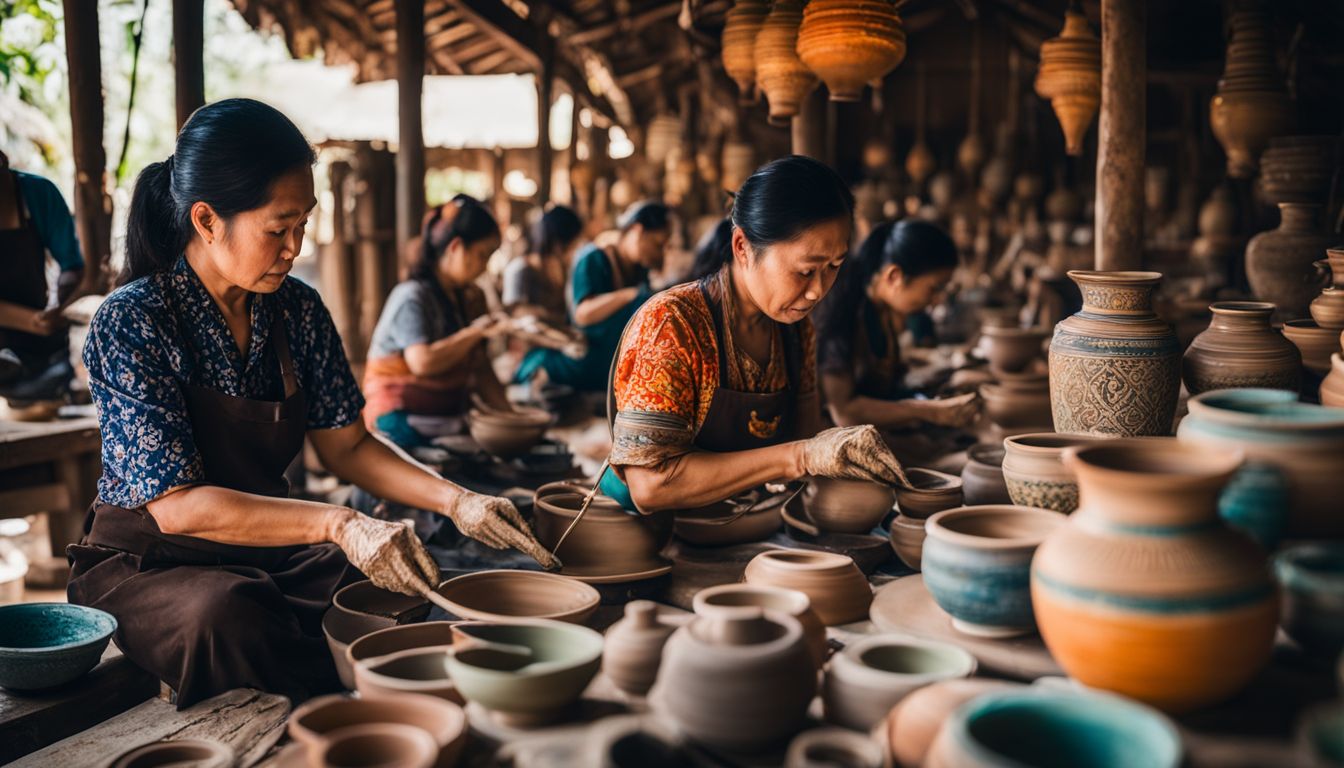
In the 18th century, a new Thai pottery style arose. It was called Benjarong. This word means “five colors”. The artists made it in a special way by hand, for only Thai royalty at first.
Plates, dishes and boxes for jewelry were common items.
Chinese potters came to Sukhothai during the late 13th century. This event marked huge growth in Thai stoneware tradition. Even today, their influence is seen in the designs and methods used by Thai artists.
Many years have passed since then but the art of making pottery lives on in Thailand. Artists still make things like royal treasures using ceramics techniques from old times. They learned how to do this from their families who had done it before them.
Influenced by Chinese Ming dynasty
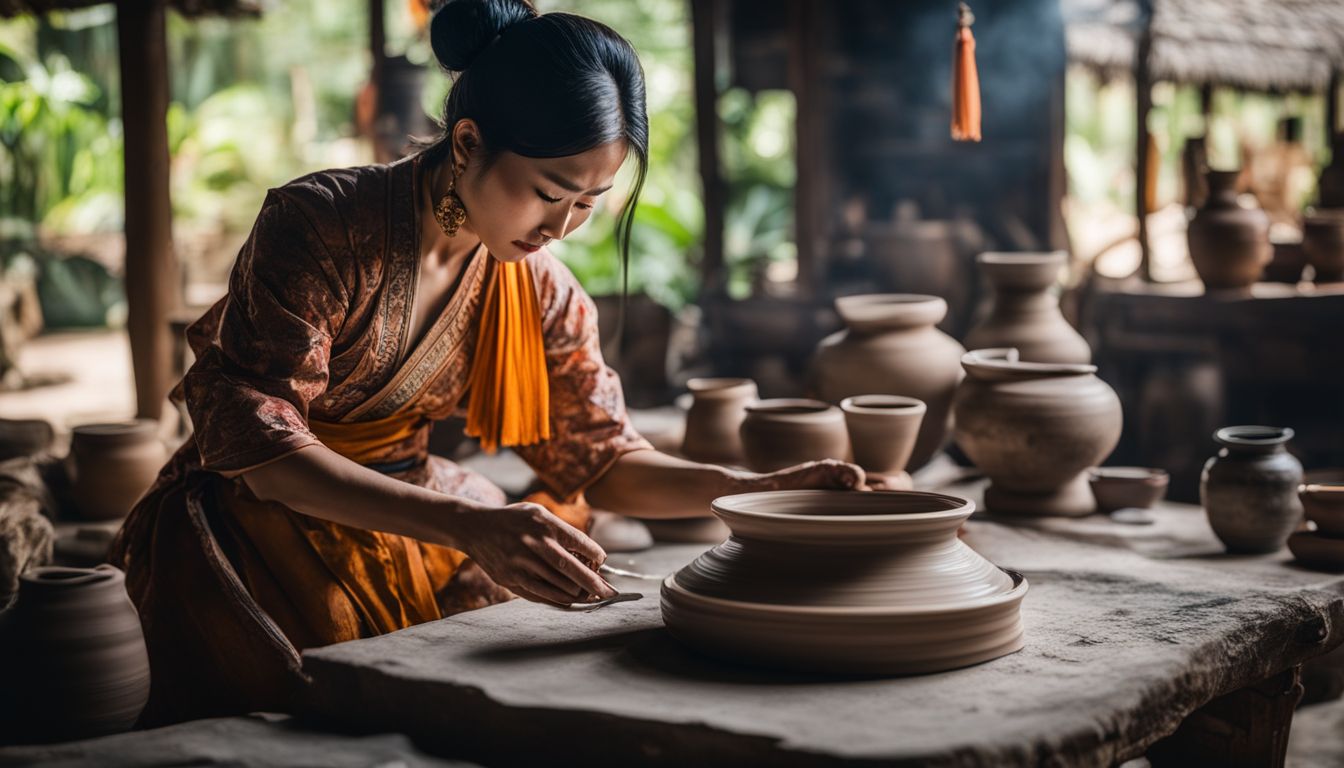
Thai pottery saw a big change during the Chinese Ming dynasty. The art in Thailand began to shine again. This was when the Sangkhalok ceramics first came to be. They were part of the Silk Road trade.
Many pots made at this time show a mix of both Thai and Chinese styles. Art from China had a big impact on how they looked and were made. Many old pieces have been found in wrecks and other old spots.
Ming Dynasty pots had their own way of looking beautiful as well! Their style is known for very special designs that are easy to see right away. Today, we still see these great works being made in Thailand.
Types of Thai Pottery
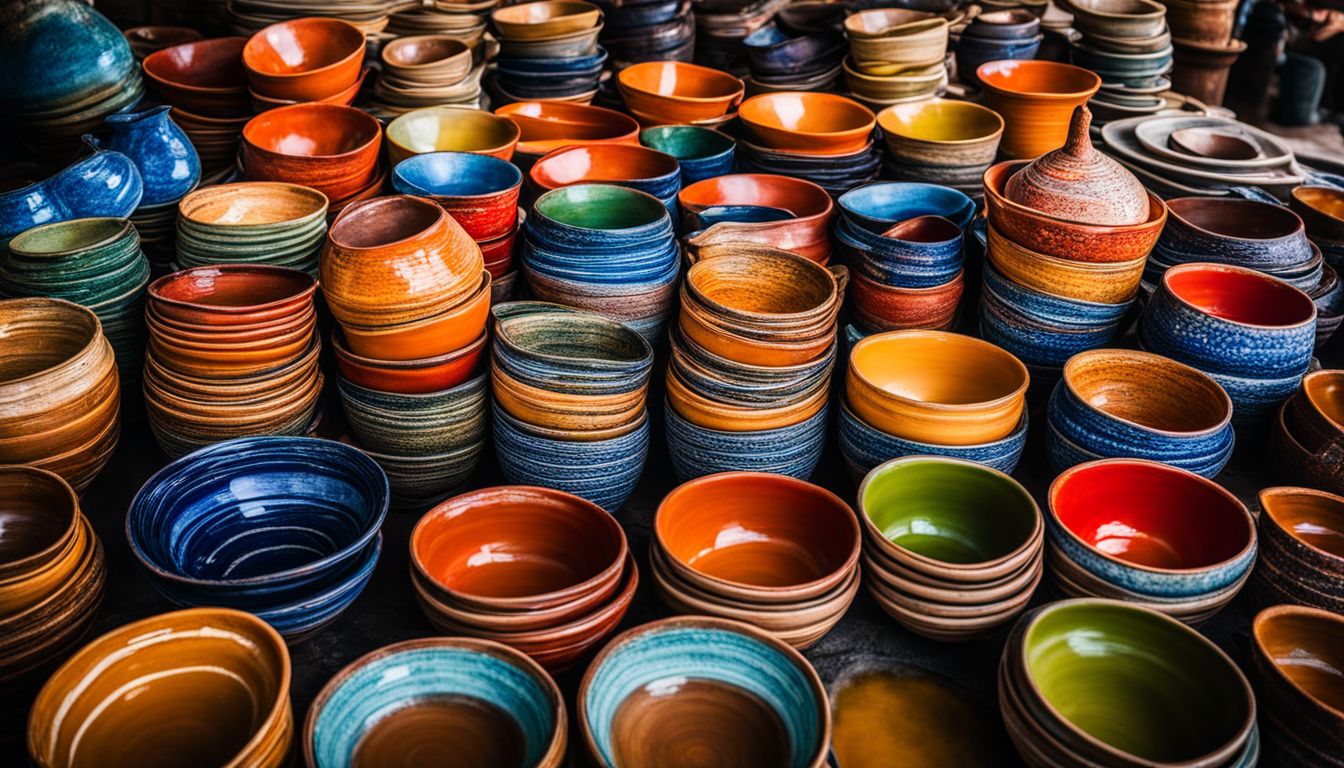
Thai pottery comes in various types, such as celadons, Benjarong, Kalong, Lampang, Nakorn Thai and Nan, Pa-O, Phan, Phayao, Phitsanulok, Sankampaeng, and Sawankhalok and Si Satchanalai.
Celadons
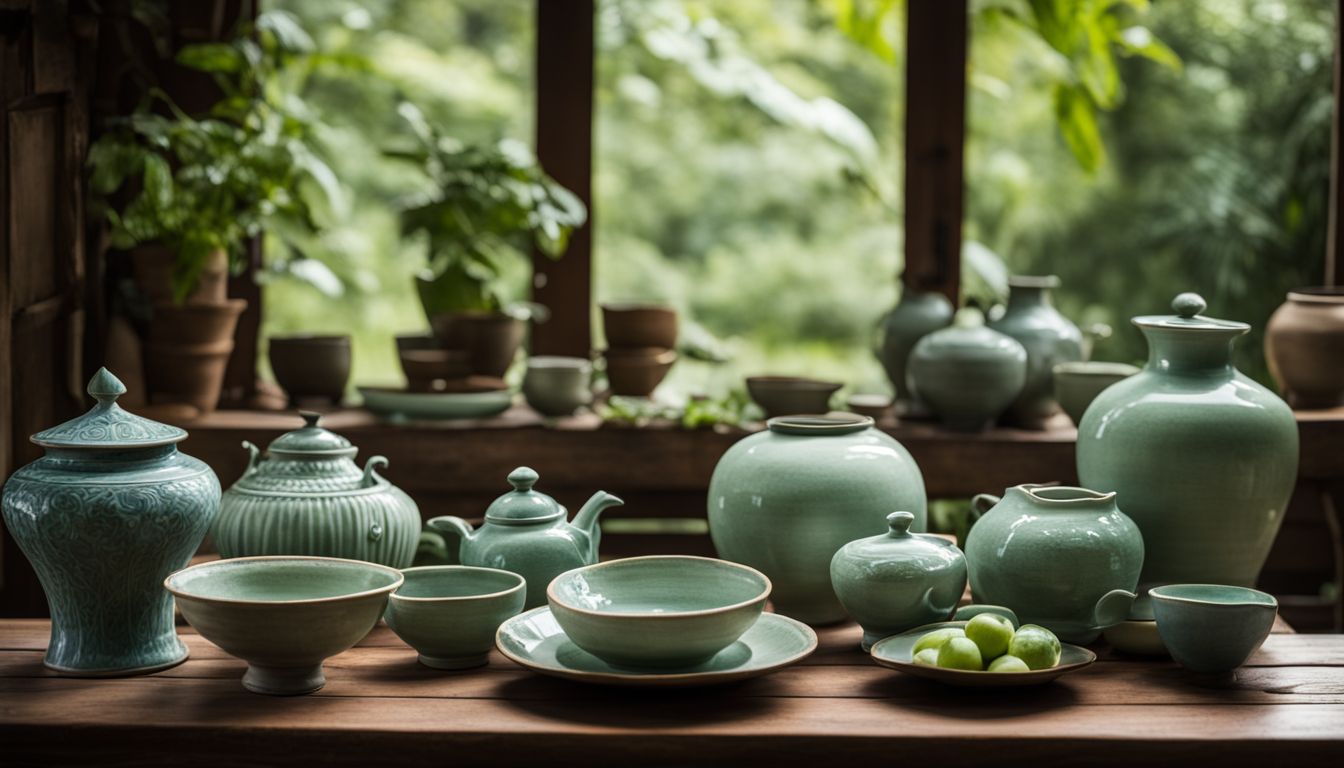
Celadons are a type of Thai pottery that is known for its beautiful shade of green. This green glaze gives celadons a unique and elegant look. Celadon pottery actually originated in China, but it has been widely adopted and celebrated in many East Asian countries, including Thailand.
Thai ceramics, including celadon, were influenced by Chinese, Vietnamese, and Khmer ceramics. In Thailand, celadon pottery holds great cultural significance and reflects the society, culture, and way of life in the country.
It has a rich history deeply rooted in Thai tradition, literature, and patterns. The jade green color of Thai celadon is distinctive and makes these pieces highly sought after as collectible items or decorative pieces.
Benjarong
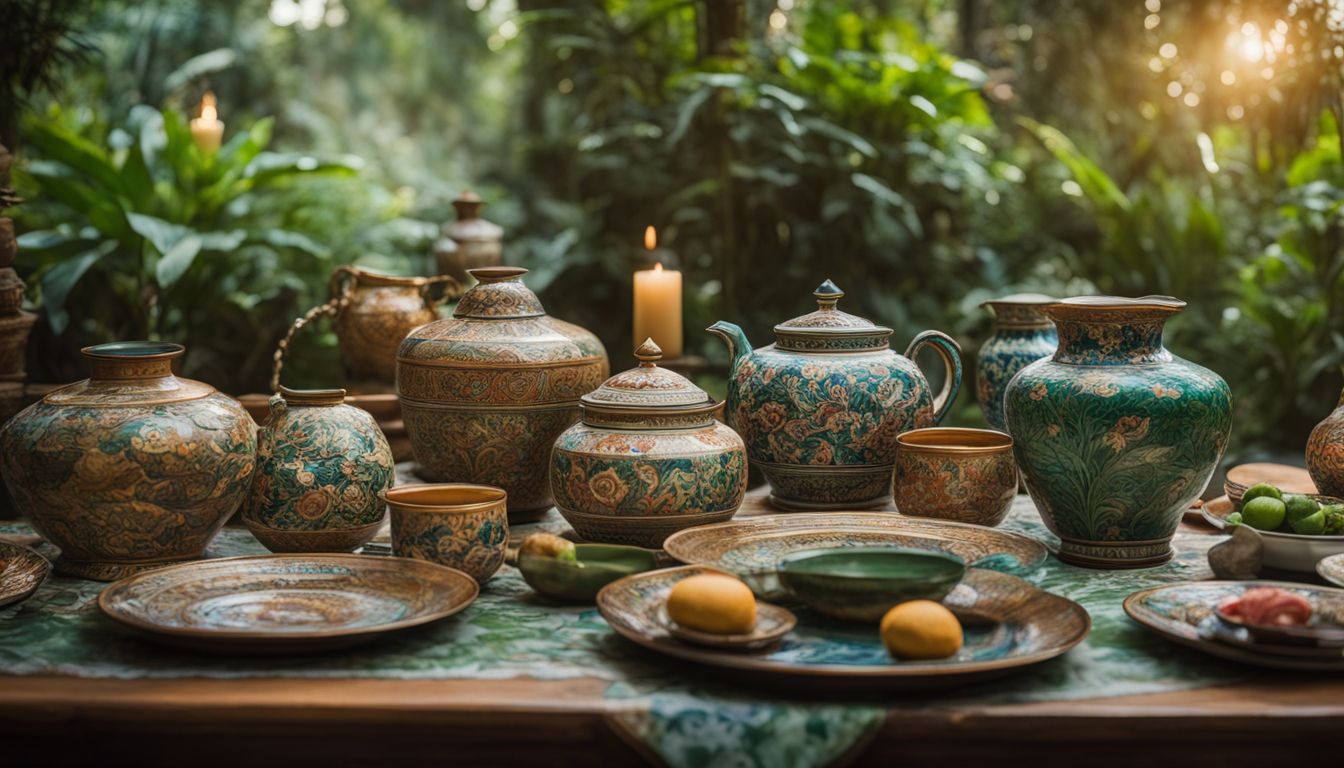
Benjarong is a traditional style of Thai pottery that has a rich history and is highly valued in Thailand. Originally made for the Thai royal family and aristocracy, Benjarong pottery is known for its five basic colors – red, green, yellow, white, and black.
This type of pottery features intricate Buddhist motifs and designs, making it truly unique. It is often used as gifts or displayed in homes and offices throughout Thailand. The stunning craftsmanship and attention to detail make Benjarong pottery a true work of art.
In addition to its aesthetic appeal, Benjarong pottery also holds cultural significance in Thailand. The designs on the pottery often depict scenes from Buddhist mythology or important historical events.
Each piece tells a story and carries with it a sense of tradition and heritage. Whether you are looking for a decorative piece for your home or office or want to give someone a special gift from Thailand, Benjarong pottery is definitely worth considering.
Its beauty and intricacy will surely leave an impression on anyone who sees it.
Kalong
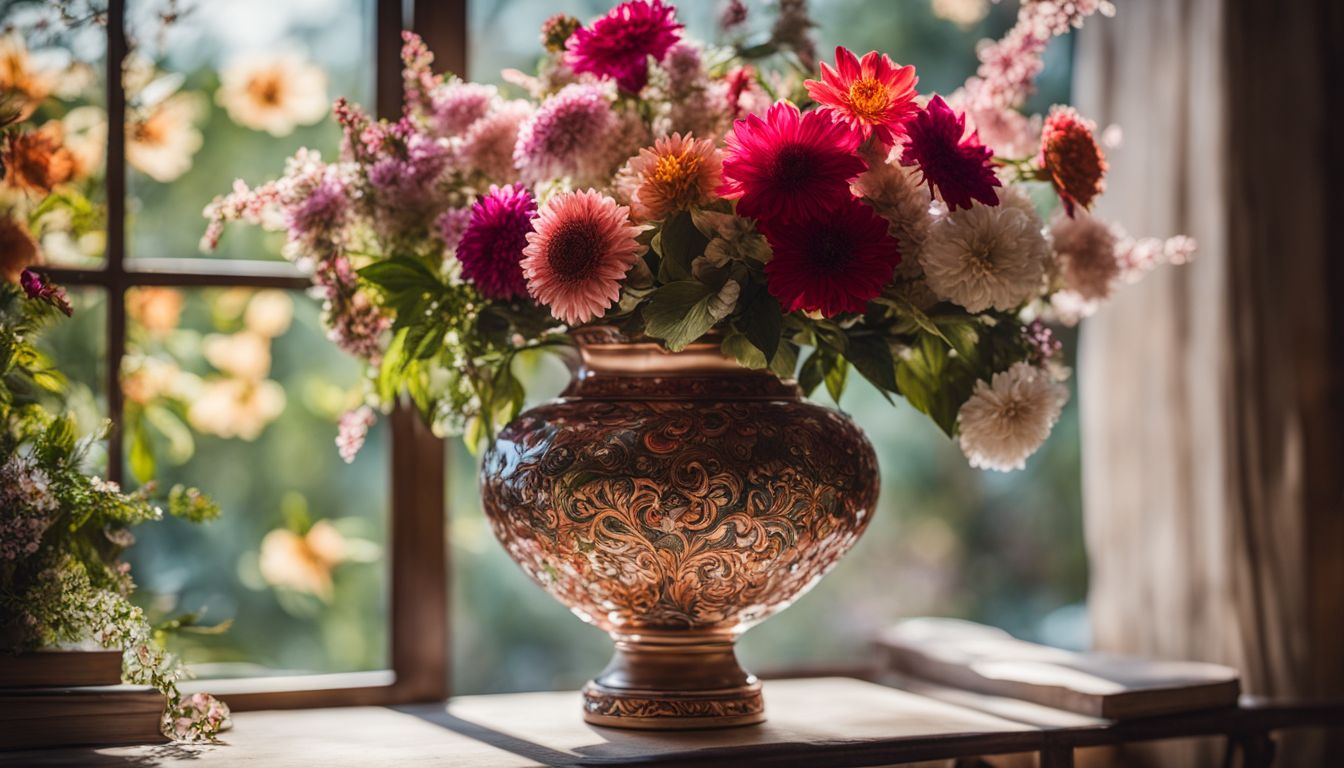
Kalong is one of the types of Thai pottery that you should know about. It is famous for its underglaze black motifs, which give it a unique and stylish look. The designs on Kalong wares are freely painted using iron brown underglaze, creating intricate patterns and detailing.
These kilns were discovered in Lanna, a kingdom located in Northern Thailand. Kalong ceramics showcase the artistry and craftsmanship of this region, making them a popular choice among collectors and pottery enthusiasts.
In conclusion, Kalong is a remarkable type of Thai pottery known for its beautiful underglaze black motifs. With their freely painted designs and rich history associated with the Lanna kingdom, these ceramics are truly an embodiment of the artistic heritage of Thailand.
Lampang

Lampang is a big city in northern Thailand, known for its pottery. It’s one of the stops that people make when they’re traveling from Bangkok to Chiang Mai. In 1950, while expanding a road, they discovered the first kilns used to make pottery in Lampang.
Besides being famous for pottery, Lampang also has beautiful natural attractions like hot springs and waterfalls. Chinese investors found Lampang perfect for making pottery because there was plenty of white clay available.
Nakorn Thai and Nan

Nakorn Thai and Nan are kiln sites located east of Sukhothai in Thailand. These historical kiln sites were visited by the Thai-Adelaide project in 1984. They hold significant importance in the history of Thai pottery production and ceramic art.
The kilns at Nakorn Thai and Nan were active during the 15th to 16th centuries, producing beautiful ceramics that showcase the craftsmanship of that era. These ceramics feature unique designs and patterns, influenced by both local traditions and Chinese Ming dynasty aesthetics.
Today, Nakorn Thai and Nan remain important sites for studying and preserving Thailand’s rich ceramic heritage.
Pa-O
Pa-O is a type of Thai pottery that comes from Southern Thailand. It is known for its distinctive earthenware pots called “Fine Paste Ware.” These pots are made using a special clay and firing technique, which gives them their unique characteristics.
The Pa-O tradition is deeply rooted in the rich history of Thai ceramics, which dates back to the third millennium BCE. Over the years, Thai ceramics have been influenced by Chinese, Vietnamese, and Khmer ceramics.
Today, Pa-O pottery continues to captivate collectors and enthusiasts worldwide with its beautiful craftsmanship and cultural significance.
This article will take you through the fascinating world of Thai pottery, exploring its history, different types like Celadons and Benjarong, techniques used such as hand-painting and gilding with gold leaf, common designs and patterns inspired by floral motifs or daily life scenes influenced by Buddhism.
Furthermore we will also look at its various uses ranging from traditional household items to ceremonial purposes as well as recommended places to see and buy authentic Thai pottery pieces like Chiang Mai Celadon Village or Baan Celadon among others.
Phan
Phan wares are a type of Thai pottery that includes bowls, plates, dishes, jarlets, kendis in bird form, and elephants. These pieces play an important role in the ultimate guide to Thailand pottery.
They are known for their elegant designs and craftsmanship. Phan wares have been influenced by Chinese ceramics as well as Vietnamese and Khmer traditions.
Thai artisans carefully handcraft each piece of Phan pottery using traditional techniques. The skill and precision needed for this art form make it truly remarkable. When you see these beautiful creations up close, you can appreciate the attention to detail and the passion that goes into making them.
If you’re interested in experiencing Thai pottery firsthand, be sure to explore the different types available – including Phan wares. You’ll discover the rich history behind each piece and gain a deeper appreciation for Thai ceramics as a whole.
Phayao
Phayao is an important location when it comes to Thai pottery. It is believed that the Phayao kilns were established after the governor of Sawankhalok fled in 1447, taking with him the skills and techniques for producing Thai ceramics.
This event marked the beginning of Thai ceramics, and Phayao played a significant role in its development. The establishment of the Phayao kingdom further solidified its association with Thai pottery production.
In Phayao, like other locations where ceramics were produced, various types of Thai pottery were made. These included celadons, Benjarong, Kalong, Lampang, Nakorn Thai and Nan, Pa-O, Phan, Phitsanulok, Sankampaeng, Sawankhalok and Si Satchanalai.
Each type had its own unique characteristics and designs.
Phitsanulok
Phitsanulok is an important location for Thai pottery production. This city is associated with different types of Thai pottery, and one notable place known for its unique styles is Ban Tao Hai in Phitsanulok.
The history and style of Ban Tao Hai pottery have been carefully researched and documented. It’s fascinating to see the craftsmanship and tradition that goes into creating these beautiful ceramic pieces in Phitsanulok.
Sankampaeng
Discover the vibrant pottery of Sankampaeng, a town located in Northern Thailand. Since its discovery by the Thai people in 1952, Sankampaeng has become renowned for its exquisite ceramics.
The artisans of this region specialize in creating a wide variety of shapes and glazes that showcase the rich tradition and craftsmanship of Thai pottery.
Influenced by Chinese, Vietnamese, and Khmer ceramics, Sankampaeng’s creations are unique and captivating. The artistry is evident in the meticulous attention to detail and the skillful use of glazing techniques.
Whether it’s delicate sculptures or functional household items, Sankampaeng offers an impressive range of ceramic masterpieces.
The influence of Thai pottery spreads beyond Thailand itself. Archaeological discoveries have found Thai ceramic pieces in necropolises as far away as Indonesia and the Philippines.
This showcases not only the beauty but also the cultural significance and historical importance of Sankampaeng’s pottery traditions. Immerse yourself in this captivating world when you explore Sankampaeng’s thriving ceramic industry.
Sawankhalok and Si Satchanalai
Sawankhalok and Si Satchanalai are famous kilns in Thailand known for producing Thai ceramics. These beautiful ceramics can be found in leading museums around the world, showcasing the exquisite craftsmanship of these ancient kilns.
Sawankhalok pottery was highly regarded and exported to countries like Japan and the Middle-East. This led to a surge in exports for Thai and Vietnamese ceramics during that time. The ruins of ancient kilns in Sawankhalok have also yielded a precious collection of ceramics, providing valuable insights into the rich history of Thai pottery.
Thai Pottery Techniques
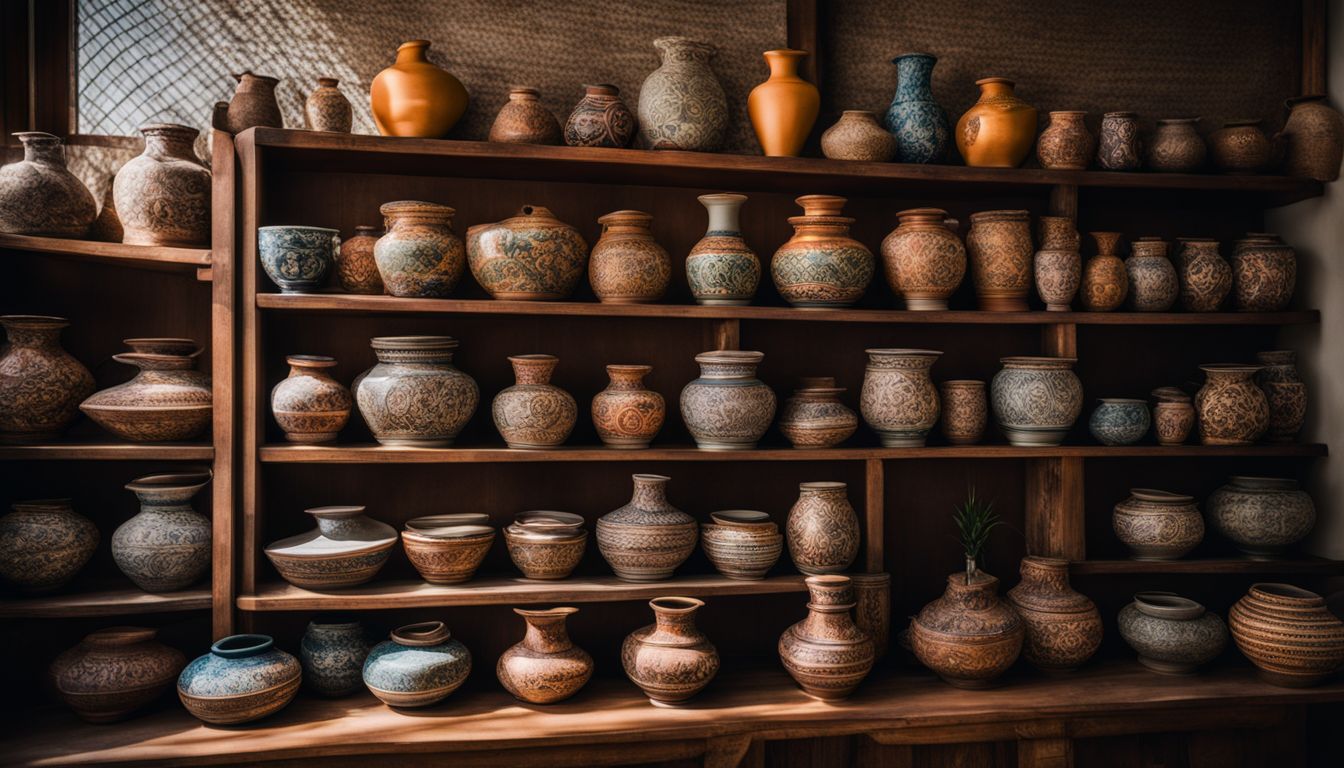
Thai pottery techniques include hand-painting and gilding with gold leaf.
Hand-painting
Thai pottery techniques often involve the beautiful art of hand-painting. This is an important part of Thai ceramics and showcases the rich history and stunning craftsmanship of the craft.
Skilled artisans use brushwork, freehand painting, and stenciling to create intricate patterns on ceramic surfaces. The designs painted on Thai pottery often incorporate cultural and religious motifs, such as Buddhist symbols and traditional Thai patterns.
Vibrant colors are used in the designs to make them stand out.
Hand-painting on Thai pottery requires precision and skill. Artists carefully apply each stroke with artistic craftsmanship, resulting in unique and eye-catching pieces. The intricate patterns created through hand-painting highlight the attention to detail that goes into making these ceramics.
Each piece tells a story, whether it’s depicting floral motifs or scenes from daily life.
The art of hand-painting is not just about decoration; it also carries cultural significance. Many Thai pottery designs are influenced by Buddhism, reflecting spiritual beliefs and traditions.
Gilding with gold leaf
Gilding with gold leaf is a special technique used in Thai pottery. It involves carefully applying thin sheets of gold onto the surface of ceramic pieces. This art requires skilled craftsmanship and experience to achieve the desired effect.
Gold leaf gilding has been used for centuries in religious art and architecture, symbolizing the spiritual significance of the decoration. In Thai ceramics, this technique has a long history dating back to the early 20th century.
It adds a touch of luxury and elegance to traditional paintings, showcasing the artistic heritage and historical tradition of Thai pottery design.
Gold leaf gilding plays an important role in Thai ceramic art. The delicate application of gold onto pottery brings out intricate details and enhances its beauty. This decorative gilding can be found on various types of ceramics, including vases, bowls, plates, and figurines.
The use of gold leaf adds a touch of opulence and prestige to these handmade creations.
The process begins by preparing the surface of the ceramic piece for gilding by smoothing it carefully. Then, small pieces of gold leaf are delicately placed onto it using brushes or other tools that allow for precision application.
The final step involves burnishing or pressing down on the gold leaf gently to ensure adhesion to the surface.
Common Designs and Patterns
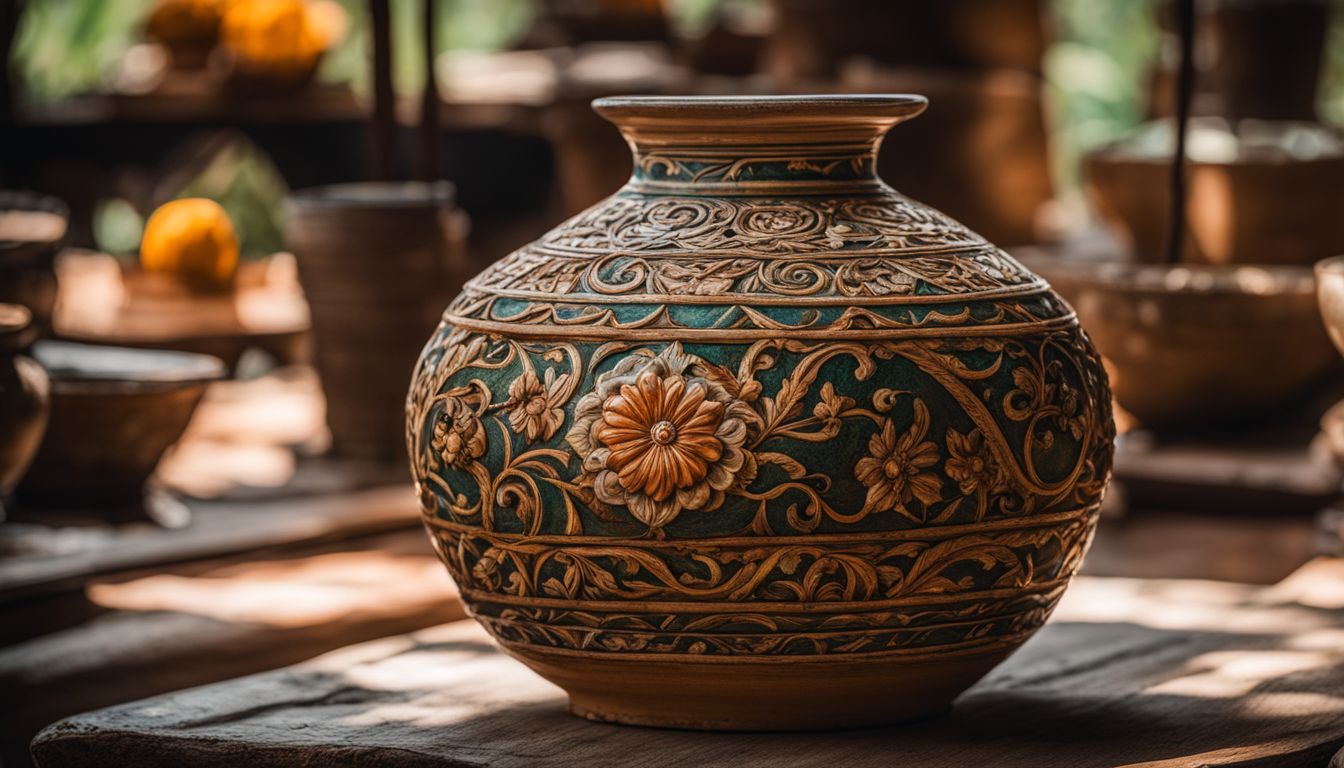
Thai pottery is known for its intricate designs and patterns that showcase the country’s rich cultural heritage. Floral motifs are commonly featured, along with depictions of daily life and influences from Buddhism.
Floral motifs
Floral motifs are very common in Thai ceramics and pottery. These beautiful designs feature flowers and other plant elements, adding a touch of nature to the artwork. One example is Sukhothai wares, which often showcase the ‘sunburst motif’ or ‘pikun blossoms’.
These intricate floral patterns bring vibrancy and life to the pieces. Another famous style is Sawankhalok pottery, known for its elegant simplicity. Delicate motifs like flowers and leaves are often featured in their designs, creating a graceful and timeless look.
Benjarong porcelain is another type of Thai pottery that showcases floral motifs. Hand-painted with intricate Buddhist designs, these pieces were once reserved for Thailand’s elite.
The use of rich floral patterns in Thai ceramics adds beauty and charm to these artistic creations.
Depiction of daily life
Thai ceramics provide a glimpse into the everyday lives of the people. The designs and patterns often showcase common activities, such as farming, fishing, cooking, and traditional ceremonies.
These depictions reflect the cultural representation and artistic heritage of Thailand. Through intricate details and vibrant colors, Thai pottery captures the essence of folk traditions and showcases the country’s rich history.
From bustling markets to serene village scenes, these ceramics offer a visual narrative of everyday scenes in Thai culture.
The depiction of daily life in Thai pottery is influenced by historical factors as well. For centuries, Thailand has been a melting pot of different cultures and influences. The designs on ceramics show traces of Indian, Chinese, Khmer (from Cambodia), Mon (from Myanmar), and Lao (from Laos) civilizations that shaped Thai culture over time.
Influence of Buddhism
Buddhism has had a big impact on Thai art and pottery. The designs and patterns often have connections to Buddhist symbols and teachings. When you look at Thai pottery, you can see the influence of Buddhism in the intricate details and motifs.
The artists combine their skill with spiritual and religious elements to create these beautiful pieces. They often depict lotus flowers, Bodhisattvas, and even incorporate Buddhist scriptures into their work.
This shows how Buddhism has shaped Thai craftsmanship and inspired the symbols and patterns found in their pottery.
Uses of Thai Pottery
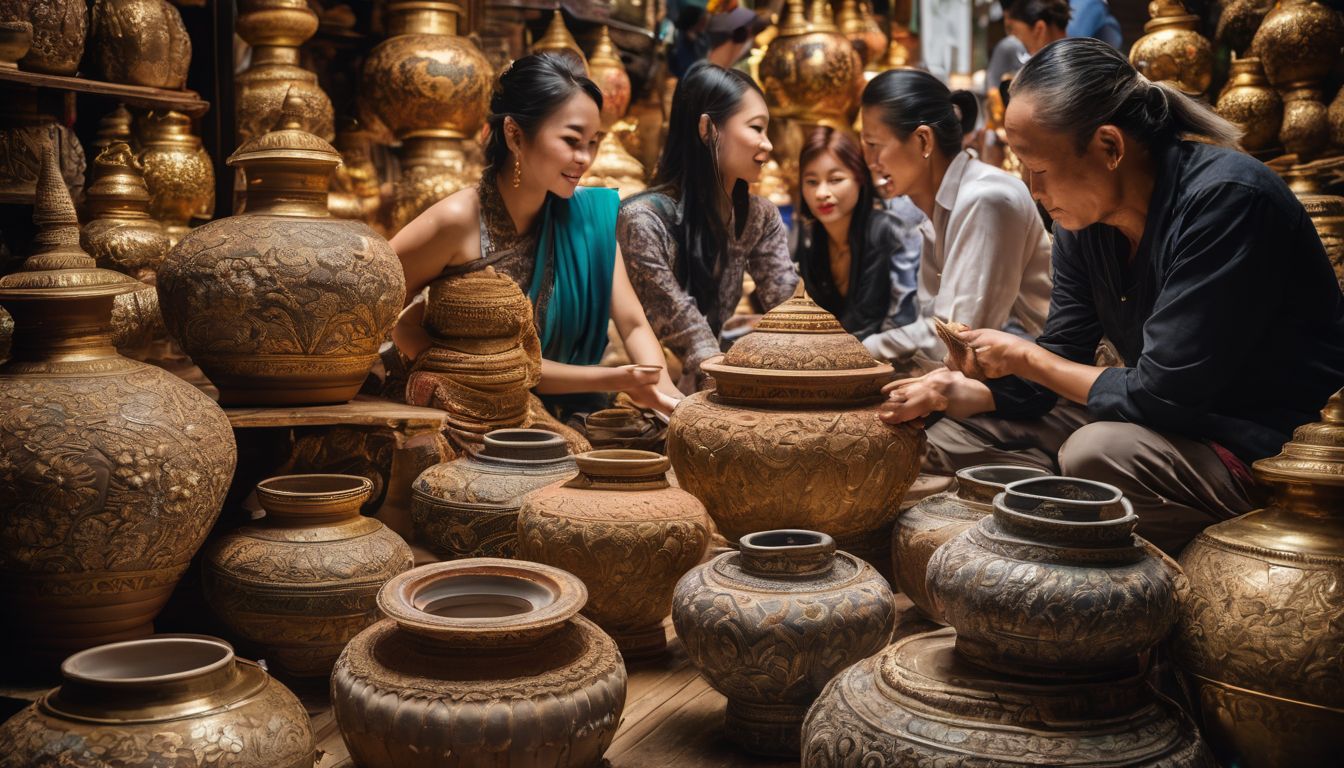
Thai pottery serves a variety of purposes, from traditional household items to decorative pieces and even ceremonial and religious use. Whether you’re looking for a unique souvenir or wanting to explore the rich cultural heritage of Thailand, the uses of Thai pottery are endless.
Traditional household items
Thai ceramics have been used as traditional household items in Thailand for many years. These beautiful pieces of pottery are often displayed in homes to add a touch of elegance and charm.
You can find ceramic bowls, plates, vases, and figurines that are handcrafted by skilled Thai artisans. The designs on these ceramics are ornate and colorful, showcasing the craftsmanship and creativity of the Thai people.
In addition to their aesthetic appeal, Thai ceramics serve practical purposes in the household. Ceramic bowls can be used for serving food or storing small items, while plates can be used for meals or as decorative wall hangings.
Vases make stunning centerpieces with fresh flowers or dried arrangements.
Ceramics have become an integral part of Thai culture, representing the country’s rich history and artistic traditions. Many tourists also purchase these ceramics as souvenirs to take home with them.
Decorative pieces
Thai pottery is not only functional but also beautifully crafted, making it perfect for decorative purposes. The intricate designs and vibrant colors of Thai ceramics make them eye-catching and unique.
You can find a variety of decorative pieces, such as vases, bowls, plates, and figurines, adorned with traditional motifs like floral patterns or scenes depicting daily life in Thailand.
These decorative pieces are often hand-painted with great attention to detail using techniques like gilding with gold leaf. They serve as lovely accents for any home decor style and are highly valued by collectors.
In addition to being aesthetically pleasing, Thai pottery holds cultural significance as well. Many decorative pieces feature Buddhist symbolism or incorporate elements of Thai cultural heritage.
Souvenirs for tourists
Thai ceramics are highly sought-after souvenirs for tourists visiting Thailand. These beautiful pieces of art can be found in various places throughout the country, such as hotel halls, department stores, and souvenir shops.
Thai ceramics are known for their intricate designs and impressive craftsmanship, which is a testament to the skill and talent of the artisans who create them.
When you purchase Thai ceramics as souvenirs, you not only bring home a unique piece of artwork but also a part of Thai culture. These handmade ceramics serve both decorative and functional purposes, with options ranging from ceramic bowls and plates to vases.
They make excellent additions to any home decor or collection.
By buying authentic Thai ceramics as souvenirs, you support local artisans and contribute to preserving this traditional craft. These ceramic items are not only beautiful but also carry cultural significance.
They allow you to cherish memories of your visit to Thailand while showcasing the rich artistic heritage of the country.
Ceremonial and religious purposes
Thai pottery has been deeply intertwined with ceremonial and religious practices for centuries. These exquisite ceramic pieces have played an important role in Thai culture, serving as offerings and creating sacred objects.
In various religious ceremonies and rituals, Thai ceramics have provided a visual representation of spirituality and tradition.
Ceramic vessels were commonly used in these ceremonies, with their unique design and bulbous shape symbolizing the sacredness of the contents they held. Often adorned with intricate patterns and motifs, these vessels served as containers for offerings to gods or ancestors.
The craftsmanship put into creating these vessels reflected the high esteem placed on religious artifacts in Thai culture.
Furthermore, Thai ceramics were not only used for rituals but also as ornamental elements in temples and other sacred spaces. They added beauty and symbolism to these surroundings, enhancing the spiritual atmosphere.
Today, visitors can still witness the presence of Thai pottery in many temples throughout Thailand.
In conclusion,
ceremonial and religious purposes hold great significance
in the world of Thai pottery.
These artistic creations are not just decorative pieces;
they represent a deep-rooted connection to spirituality
and serve as a tangible expression of Thai traditions.
Recommended Places to See and Buy Thai Pottery
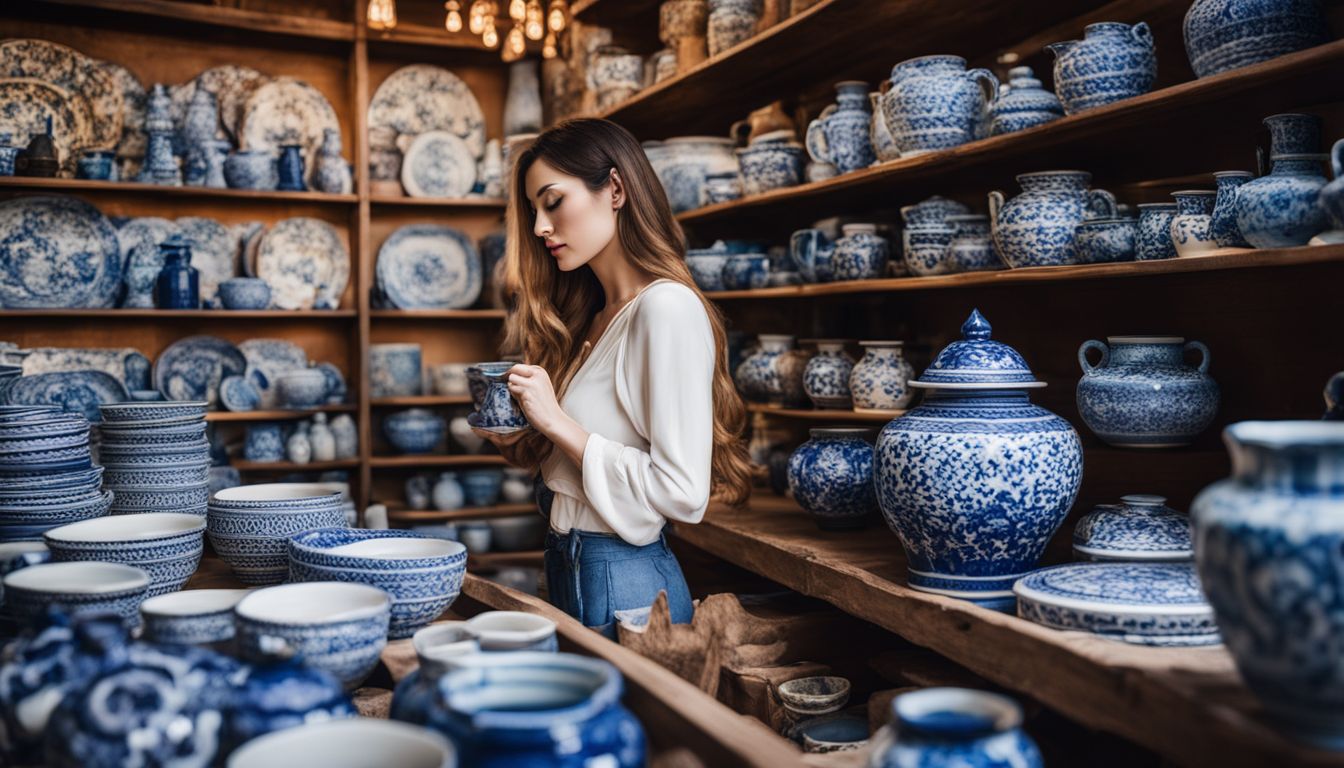
If you’re looking to see and buy Thai pottery, make sure to visit Chiang Mai Celadon Village, Baan Celadon, Benjarong Village, and the Thai Pottery Market in Bangkok.
Chiang Mai Celadon Village
Chiang Mai Celadon Village is a must-visit place if you want to see and buy authentic Thai pottery. This village showcases an impressive collection of ceramics, fabrics, paintings, and silverware that have been collected over many years by the owner.
It is also home to the famous Chiang Mai Celadon brand, which produces and distributes beautiful celadon ceramic pieces, including dinnerware and home décor items. If you’re specifically looking for traditional celadon pottery, Mengrai Kilns in Chiang Mai is where you’ll find some of the country’s biggest and finest celadon factories.
So make sure to include Chiang Mai Celadon Village on your itinerary when exploring Thai pottery!
Baan Celadon
Baan Celadon is a pottery producer located in Chiang Mai, Thailand. They have built a strong reputation for their beautiful ceramics and offer custom pottery orders to meet individual preferences.
What sets Baan Celadon apart is their extensive collection of Thai ceramics, fabrics, paintings, and silverware that they have curated over many years. This showcases the rich history and beauty of celadon ceramics in Thailand.
If you are looking to explore the world of Thai pottery or add unique pieces to your collection, Baan Celadon is definitely worth a visit during your Chiang Mai pottery shopping experience!
Benjarong Village
Benjarong Village, located in Samut Sakhon province near Bangkok, is a must-visit place for pottery enthusiasts. This village is famous for its production of Benjarong pottery, a traditional handmade style that was originally made exclusively for the Thai royal family and aristocracy.
The village offers a homestay experience where visitors can learn about the art of making Benjarong pottery through workshops and demonstrations. One prominent business in the village is Thai Benjarong (formerly known as Siam Ceramic Handmade), a family-run enterprise that specializes in producing and selling exquisite porcelain ware.
For those looking to bring home unique souvenirs or gifts from Thailand, Benjarong ceramics are an excellent choice. With its rich history and commitment to preserving this ancient craft, Benjarong Village showcases the beauty and craftsmanship of Thai pottery.
Thai Pottery Market in Bangkok
The Thai Pottery Market in Bangkok is found in Chatuchak Market, which is a vibrant and bustling place to explore. This market offers an array of beautiful ceramics that showcase the rich tradition and history of Thai pottery.
You can find a wide selection of pottery products, including bowls, plates, vases, and decorative items. The market provides a perfect opportunity for both locals and tourists to discover unique pieces crafted by talented artisans.
When visiting the Thai Pottery Market in Bangkok, you’ll be able to witness firsthand the skill and craftsmanship that goes into creating these stunning ceramics. From intricate hand-painted designs to gilding with gold leaf, each piece reflects the cultural importance of Thai ceramics.
Whether you’re looking for traditional household items or one-of-a-kind souvenirs, this market has something for everyone.
So take your time browsing through the stalls at the Thai Pottery Market in Bangkok. Immerse yourself in the beauty of Thai pottery as you admire the various designs and patterns inspired by nature, daily life scenes, and Buddhism.
Collectible Thai Pottery
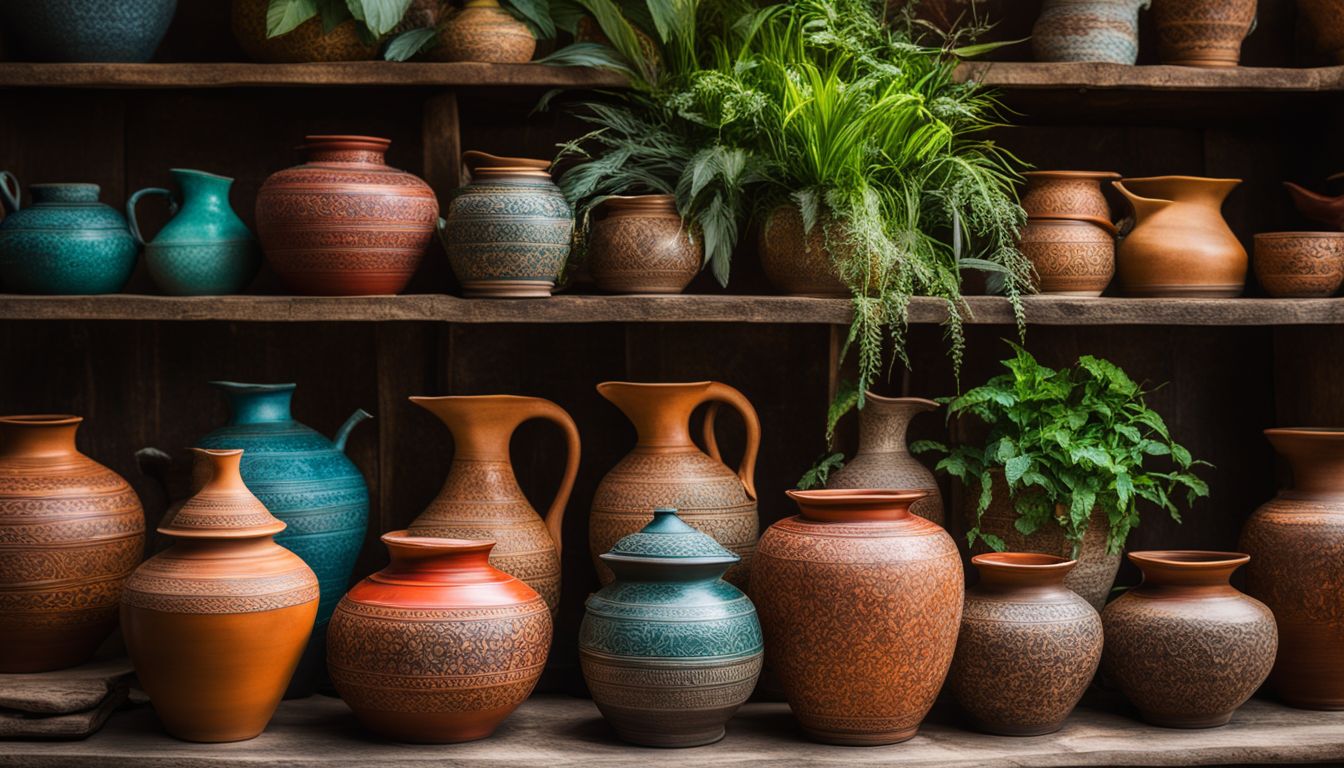
Highly valued by collectors worldwide, Thai pottery includes a vast array of antique pieces and unique, handcrafted modern designs.
Highly valued antique pieces
Thai pottery has a rich history, and there are some antique pieces that hold great value. One example is Benjarong porcelain, which was hand-painted with intricate Buddhist motifs.
Back in the 18th and 19th centuries, these exquisite pieces were reserved only for Thailand’s elite. Today, surviving antique Benjarong pieces are quite rare and can usually be found in museums.
These collectible Thai ceramics are considered museum pieces and treasured artifacts from the past.
Another type of highly valued antique Thai pottery comes from the Sawankhalok and Si Satchanalai region. Dating back to the 14th and 15th centuries, these ceramics are sought after by collectors worldwide.
These ancient pots feature delicate designs inspired by nature, such as lotus flowers or stylized fish patterns.
Unique and handcrafted modern pieces
Thai pottery is not limited to traditional designs and techniques. In fact, there are many talented artisans in Thailand who create unique and handcrafted modern pieces of collectible pottery.
These contemporary works of art showcase the creativity and innovation of Thai ceramic craftsmanship.
These modern pieces often incorporate new materials, colors, shapes, and patterns that give a fresh twist to the traditional art form. Skilled artisans experiment with different glazing techniques, textures, and finishes to create one-of-a-kind pieces that stand out from the crowd.
Collectors of Thai pottery appreciate these modern creations for their artistic value and uniqueness. Each piece tells a story through its design and craftsmanship. Whether it’s a striking sculpture or a functional vase with intricate details, these handcrafted ceramic pieces bring beauty and sophistication into any space.
How to Care for Thai Pottery
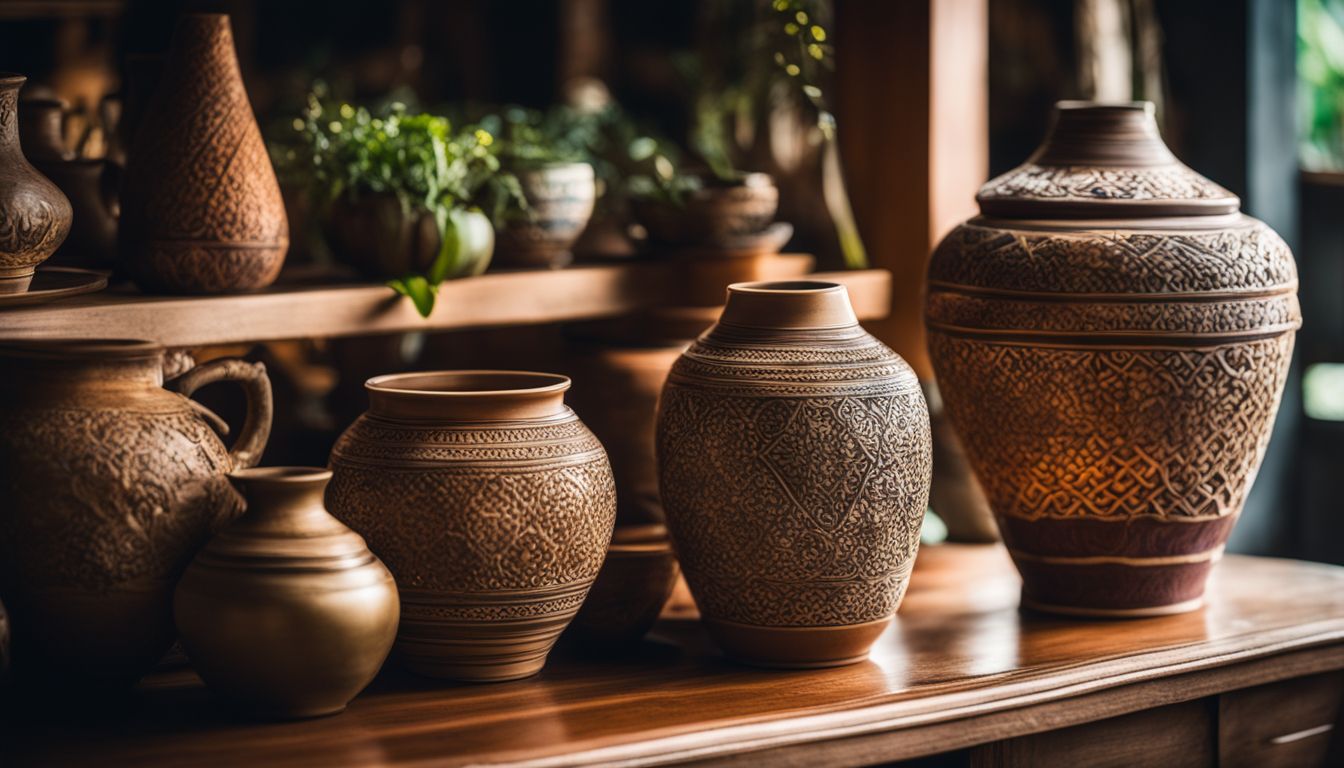
To care for Thai pottery, gently clean it with a soft cloth or brush and avoid using harsh chemicals. Display and store the pottery in a cool and dry place to prevent damage.
Cleaning and maintenance tips
To properly care for Thai pottery, it is essential to handle it with caution. Avoid touching the painted or glazed surfaces directly to prevent any damage. Always make sure your hands are clean before handling the pottery, as dirt and oils can cause stains or discoloration over time.
When it comes to cleaning, a gentle approach is necessary. Use a soft cloth or sponge with mild soap and warm water to remove any dust or dirt gently. Do not use abrasive cleaners or scrubbing brushes as they can scratch or crack the delicate ceramic surface.
Taking these steps will help preserve the beauty and integrity of your Thai pottery collection.
Maintaining the condition of Thai ceramics goes beyond just regular cleaning. It’s important to store them properly too! Use padded shelves, cabinets, or display stands that provide support and prevent accidental bumps or falls that could lead to breakage.
Additionally, avoid exposing your pottery pieces to extreme temperature changes as this can cause cracking due to expansion and contraction of materials. The proper storage environment should be dry and well-ventilated while avoiding direct sunlight exposure which may fade colors over time.
Displaying and storing properly
Properly displaying and storing Thai pottery is essential for preserving its beauty and condition. When you display your ceramics, choose a location that enhances their visual appeal.
Consider placing them in well-lit areas where their colors and details can be fully appreciated. You can also use stands or shelves to elevate the pieces and create an eye-catching arrangement.
To protect your Thai pottery from damage and deterioration, it’s important to store them correctly. Keep them in a cool, dry place away from direct sunlight, as exposure to heat and light can cause fading or cracking.
Avoid storing them near sources of sulfur, such as gas pipes or certain types of wood, as sulfur can react with the ceramic glaze.
By following these proper care techniques, you can ensure that your Thai pottery remains in excellent condition for years to come. Protecting it from air exposure and sulfur exposure will help preserve its visual aesthetics and prevent any potential damage or deterioration.
Conclusion
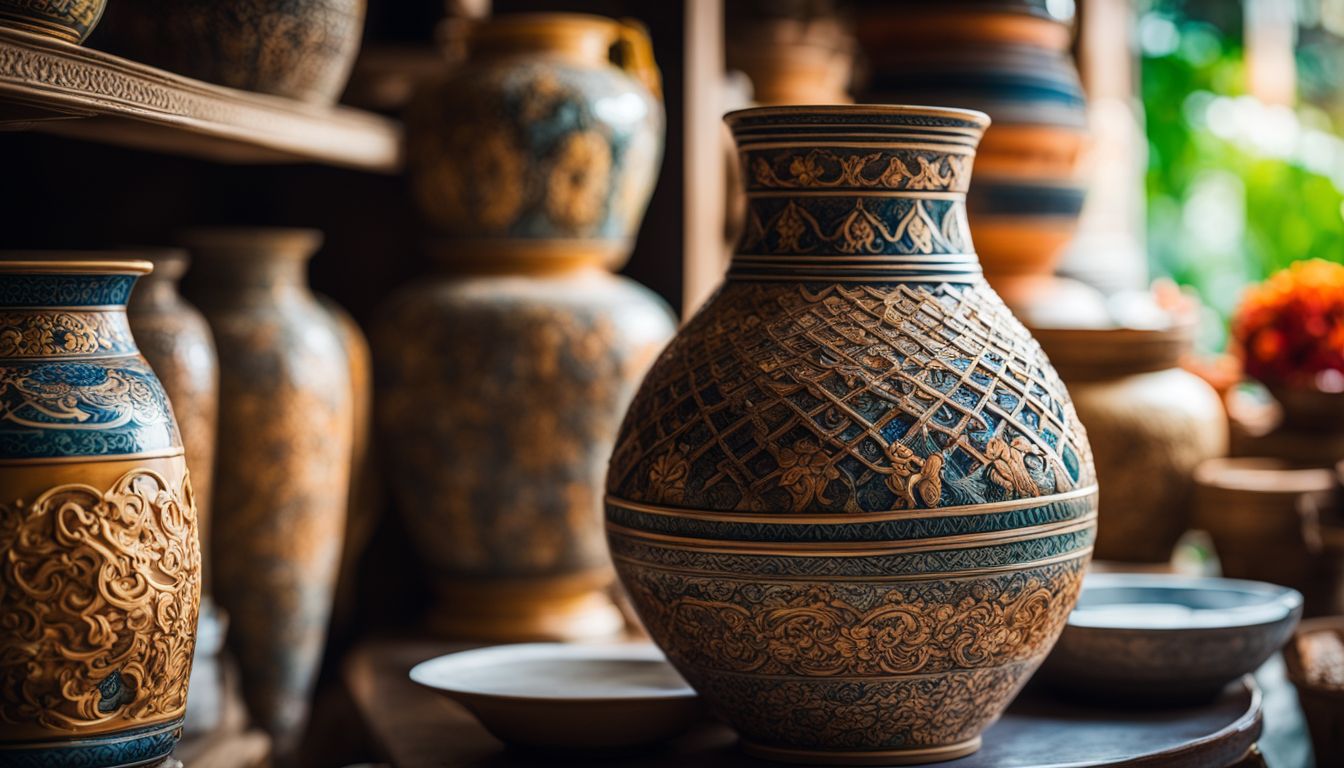
Discover the rich history and stunning artistry of Thai pottery. From its ancient roots to the intricate designs of Benjarong porcelain, Thailand’s pottery tradition is a true work of art.
With this guide, you can explore the various types, techniques, and uses of Thai pottery while discovering recommended places to see and buy these beautiful creations. Immerse yourself in the world of Thai ceramics and uncover the beauty that lies within each piece.
FAQs
1. What is the history of Thailand pottery?
Thailand pottery has a rich history that dates back thousands of years, with each region having its unique styles and techniques.
2. What makes Thai pottery artistry stunning?
The stunning artistry of Thai pottery lies in its intricate designs, vibrant colors, and attention to detail, showcasing the skilled craftsmanship passed down through generations.
3. Are there different types of Thai pottery?
Yes, there are various types of Thai pottery, including celadon (green glaze), Benjarong (multicolored enamel), Sangkhalok (brown stoneware), and Lai Nam Thong (gold leaf overlay).
4. How can I appreciate Thai pottery as an art form?
You can appreciate Thai pottery as an art form by visiting museums or galleries that showcase historical pieces and modern creations. Observing the details and learning about the cultural significance adds to the appreciation.
5. Can I learn how to make Thai pottery?
Yes, you can learn how to make Thai pottery through workshops or classes offered by experienced artisans who will teach you traditional techniques and guide you in creating your own piece.


